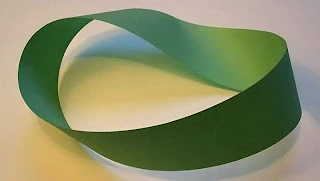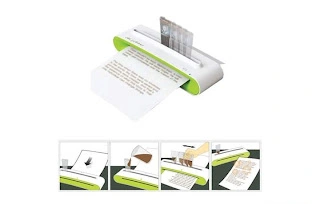‘Topology’ or ‘Topology’ is a branch of mathematics that deals with the geometry of certain objects. This is sometimes referred to as ‘rubber-band geometry’.
Many objects seem very simple and simple, but the mathematical explanation of those objects is quite complex. If you want to give an example of such an object, perhaps there is no greater precedent than the ‘Möbius strip’.
Simply put, a Mobius strip is an object that has only one surface. And it is possible to make such items at home in seconds. All you need is a piece of paper and scotch tape.
A Mobius strip is made by joining two ends of a piece of paper cut a bit long like a ribbon with tape, only one end needs to be twisted.
That is, if two ends of a long piece of paper are joined together, its shape will be circular. However, if one end is rotated 180 degrees prior to taping, a Mobius strip will be formed.
This Möbius strip looks like a regular circular paper but its geometric properties are surprising. As mentioned earlier, it has only one surface. If you start tracing with a pen at one end of a paper Möbius strip, you will go around the circle twice and come back to where you started.
That is, the pen has touched the entire surface of the Mobius strip made of paper. If you open the tape again, you will see that two opposite sides of the paper have been marked. This means that the paper had two surfaces before being joined. He is turned into a Mobius strip.
This simple shape object called Möbius strip is considered essential in the discussion of topology or topography. And the Möbius strip serves as an excellent example of various mathematical principles.
One of these principles is called ‘non-orientability’. To determine the location of an object on a graph or drawing page, its coordinates or coordinates must first be placed there. And when mathematicians cannot fix the coordinates of an object, it is considered ‘non-orientable’.
There are some interesting examples of this principle in practice. For example, scientists believe that our universe may also be non-orientable.
If this assumption is true, a confusing situation will arise. For example, suppose a rocket carrying astronauts flies into space for a long enough time to return to Earth. If the universe is non-orientable, then the bodies of all the astronauts in the rocket will move in opposite directions.
In other words, what the astronauts saw in the mirror before their departure, will be their actual makeup after the universe turns around. Their physical structure will be completely reversed. At the same time everything including all the objects or machines with them will be overturned.
After returning, the astronauts’ hearts will be on the right side instead of the left side. Those who were right-handed will become left-handed. If one of the astronauts is missing his right leg before departure, he will be found to be missing his left leg upon return.
A Möbius strip is a non-orientable object. If the universe is like this, then if it crosses its entire surface, these strange events described above should happen.
Many people may be at least somewhat surprised to read this much. But to get an idea about the Mobius strip, we need to go back a little further. Where did the Möbius strip originate and how could this complex geometric object be made by simply twisting pieces of paper?
History Of The Mobius Strip
In 1858, the German mathematician August Ferdinand Möbius (August Ferdinand Möbius) discovered this geometric structure while researching geometric theory. From there the object was named after Augustus Mobius.
However, around the same time as August Möbius, a mathematician named Johann Listing also discovered this structure. But because Johann did not publish his research anywhere, August Moebius is recognized as its discoverer in the pages of history.
As mentioned earlier, a non-orientable and single-surface object is a Möbius strip.
When one end of a paper is rotated 180 degrees, this twist is called ‘half-twist’ in English. And when two ends of any tape or paper are joined, one end is half-twisted to form a Mobius strip. However, doing this half-twist any odd number of times instead of once will create a Möbius strip.
This one-surface structure has fascinated artists and mathematicians since its discovery. An example is the famous Dutch artist Maurits Cornelis Escher, who made M.C. Better known as Escher (M.C. Escher). He has two paintings named ‘Möbius Strip 1’ and ‘Möbius Strip 2’.
The Role Of Möbius Strip In Forming The Basis Of Topography
The Möbius strip also played a major role in the development of a branch of mathematics called topology. This branch of mathematics deals with the geometric properties of an object that remain unchanged even after it is deformed or stretched.
Topology plays an important role in certain branches of mathematics and physics. Among these, two prominent branches are ‘Differential Equations’ or ‘Insular Equations’ and ‘String Theory’.
There is a funny saying about those who research topology: “A topologist is someone who can’t tell the difference between a donut and a coffee mug”.
Indeed, according to mathematical topology, donuts and coffee mugs can be analyzed in the same way. Imagine a coffee mug with the bottom or bottom surface rising upwards. And slowly the structure of the mug is becoming equal to its handle.
Simply put, if the handle of the mug can be thought of as half of the doughnut, then the rest of the mug can be thought of as the other half of the doughnut.
As strange as it may sound, this is exactly how topologists think. And to understand the subject more clearly there are several videos on YouTube, you can watch them. As with donuts and coffee mugs, so are Mobius strips.
Uses Of Möbius Strips In The Real World
The usefulness of Mobius strips is not limited to mathematical theory. It has some great uses in the real world. Mobius strips are used to help students understand the structure of complex objects. Again, the material of this structure is used to make various machines.
A Mobius strip has only one surface. As a result, Möbius strips are often used in devices such as conveyor belts, so that all sides of the belt are used equally.
Associate Professor of School of Mathematics, University of New South Wales, Australia N. J. Wildberger explains this with the example of a driving belt in various machines. According to him, engineers use the Möbius strip structure in different machines, so that both sides of the belt are used equally.
Examples of Möbius strips are also found in architecture. China’s Ukaji Bridge (Wuchazi Bridge) can be an example of this.
The concept of Mobius strip in childhood has helped many in higher education as well. One man who benefited from Mobius strips is Dr. Edward English Jr. He is a teacher by profession. Before that, he was an optical engineer.
As a child, Dr. Edward was introduced to the workings of Mobius strips by his teacher. Also taught how to make Mobius strips out of paper. His teacher showed that a fun phenomenon occurs when a Mobius strip is made and cut in half along its length.
A common circular object is cut lengthwise and bisected to produce two circular objects. But cutting the Mobius strip in two like this creates a large circular object.
When Dr. Edwards graduated from high school and began his PhD, this Mobius strip concept he learned as a child helped him understand his studies. He could easily grasp that an object can be in different states or states.
For example, it was easy to understand how electrons spin up or down, which in physics is called ‘up-spin’ or ‘down-spin’. Apart from this, he could easily visualize various quantum mechanics concepts. Because he understood these concepts with the formation of the Mobius strip learned as a child.
Thus, many like Dr. Edwards began to understand complex geometry and mathematics for the first time with the help of Mobius strips.
How To Make a Mobius Strip
Making a Mobius strip is pretty straightforward. Take a piece of paper and cut it lengthwise into a thin ribbon. Its width can be 1 to 2 inches wide.
After cutting the paper in this way, one of its ends should be turned or twisted by 180 degrees, which is also called ‘half-twist’. Then attach the twisted end to the other end with some tape. That’s it! Your Mobius strip will be ready.
If you notice, this Möbius strip is basically nothing but a circle or ring-shaped object with only a half-twist in it.
But to understand the unique features of this simple-looking object, you have to touch one end of it with your finger. You can do the work with a pen instead of your finger. You will see that the finger or the pen is right back where it started.
And if you cut the Mobius strip along its length and bisect it, you will see that a large circular object is formed. However, after the new creation, this circular object will no longer be a Möbius strip. Because it will have 4 half twists instead of one half twist. And its surface will also have two.
These excellent properties of the Mobius strip helped Dr. Edward to understand all the complex theories of physics.



